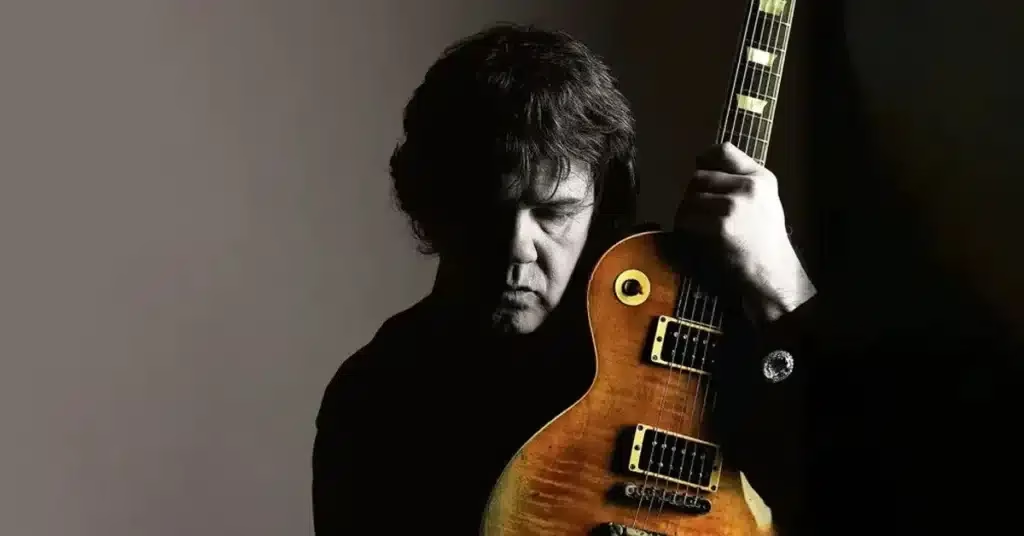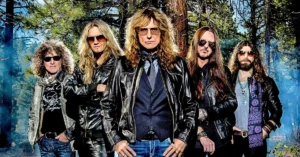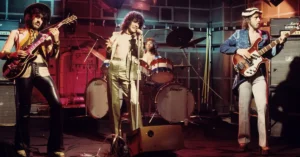Gary Moore: The Soulful Virtuoso of Blues and Rock
Gary Moore. Early Life and Musical Roots
Full Name: Robert William Gary Moore
Born: April 4, 1952 – Belfast, Northern Ireland
Died: February 6, 2011 – Estepona, Spain
Gary Moore grew up in Belfast, immersed in the music of Elvis Presley, The Shadows, and The Beatles. Inspired by bluesmen like Albert King and Peter Green, he began playing guitar at age 8 and was performing professionally by 14. Despite being left-handed, he played right-handed, adding to his unorthodox style.
Gary Moore. Early Career: Skid Row and Thin Lizzy
In the late 1960s, Moore joined the Irish blues-rock band Skid Row, which briefly featured Phil Lynott on vocals. This partnership would evolve into a lifelong musical relationship.
✦ Thin Lizzy
Moore had three stints with Thin Lizzy, most notably in 1974 and again in 1979 for the album Black Rose: A Rock Legend, which featured the standout track “Róisín Dubh (Black Rose): A Rock Legend.”
His searing lead guitar and Celtic flair complemented Lynott’s poetic songwriting. Though Moore was never a permanent member, his collaborations with Thin Lizzy were essential to their legacy.
Gary Moore. Solo Hard Rock Era (Late 1970s–1980s)
Gary Moore’s solo career blossomed in the late ’70s with a focus on hard rock and guitar virtuosity, especially in the wake of Van Halen’s rise and the guitar-hero boom.
✦ Corridors of Power (1982)
- Moore emerged as a melodic hard rock soloist
- Songs like “End of the World” and “Always Gonna Love You” showcased his emotional depth
✦ Victims of the Future (1984)
- Blended hard rock with political themes (e.g., “Murder in the Skies”)
✦ Wild Frontier (1987)
- Paid tribute to Phil Lynott, who died in 1986
- Infused with Celtic rock energy
- Hits: “Over the Hills and Far Away,” “Wild Frontier”
Though he was successful in the hard rock and metal scenes, Moore always carried the soul of a bluesman, which he would soon embrace more directly.
Gary Moore. Blues Reinvention and Worldwide Recognition (1990–1997)
✦ Still Got the Blues (1990)
- A career-defining album that marked Moore’s return to his blues roots
- Featured Albert King, Albert Collins, and George Harrison
- Title track “Still Got the Blues” became his signature song — a slow, emotional solo that rivals any in rock history
✦ After Hours (1992)
- Continued the blues momentum with tracks like “Cold Day in Hell” and “Story of the Blues”
- Balanced classic blues stylings with Moore’s rock background
✦ Blues for Greeny (1995)
- A heartfelt tribute to Peter Green, Moore’s idol and mentor
- Played using Green’s legendary 1959 Les Paul guitar
This blues phase brought Moore international acclaim, especially in Europe and Japan, where his emotional expressiveness and tone-driven style were revered.
Gary Moore. Later Years and Musical Exploration (1999–2011)
In the 2000s, Moore continued exploring different styles while returning occasionally to rock and blues.
✦ Back to the Blues (2001), Power of the Blues (2004)
- Rawer and more stripped-down
- Songs like “You Upset Me Baby” and “That’s Why I Play the Blues” captured his late-career groove
✦ Scars (2002)
- A return to rock-blues power trios, with a heavier sound
- Showed influence from grunge and modern blues-rock
✦ Bad for You Baby (2008)
- His final studio album before his untimely death
- Showed Moore still playing with fire, soul, and clarity
He died of a heart attack in 2011 while on vacation in Spain, shocking the rock and blues world.
Playing Style and Gear
Gary Moore was known for:
- Searing vibrato and expressive bends
- Long, emotionally charged solos
- Use of Les Paul guitars, especially Peter Green’s
- Blending British blues, Celtic melody, and American soul
He could shred with intensity or whisper with heartbreak, often within the same song.
Legacy and Influence
Gary Moore is remembered as:
- A guitarist’s guitarist — respected by Eric Clapton, Joe Bonamassa, Joe Satriani, Zakk Wylde, and more
- A key figure in the revival of blues in the 1990s
- A bridge between hard rock and blues, equally at home in both realms
His ballads (“Still Got the Blues,” “Parisienne Walkways,” “Empty Rooms”) remain cornerstones of emotional guitar work.
Tributes and recognition:
- Multiple posthumous compilations and live releases
- “One of the finest blues guitarists ever to emerge from the British Isles” – Guitar World
Interesting Facts
- “Parisienne Walkways” (1979) was co-written with Phil Lynott and became one of his biggest UK hits
- His early influences included jazz fusion, showcased on G-Force (1980)
- Moore never relied on flash — he was focused on tone, feel, and phrasing
- Fans include B.B. King, who once said Moore was “among the best blues players in the world”





